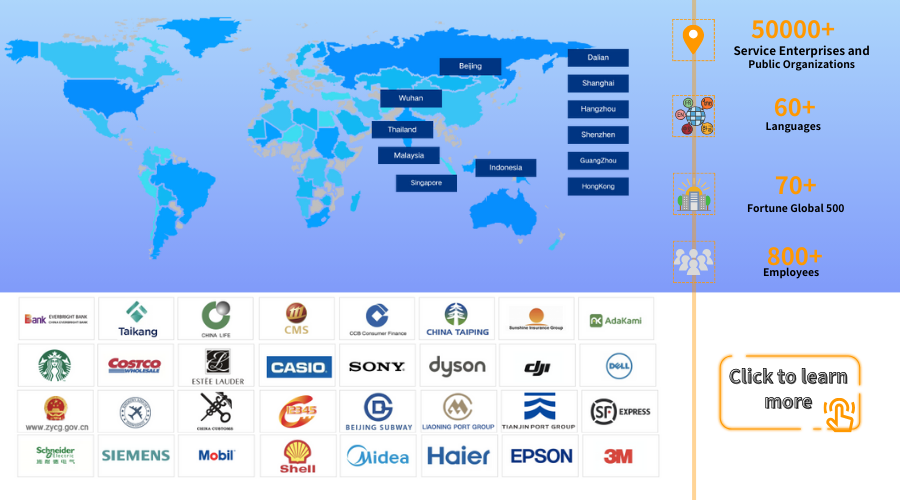How to Build an Efficient Customer Service System: Enterprise Demand Insight, Selection Strategy and Implementation Path
文章摘要:In an era where customer experience defines competitive edge, building an intelligent, flexible, and scalable customer service system is essential for all businesses. Whether startups need to respond swiftly to customer demands or large enterprises aim to standardize services, a robust system drives higher satisfaction, lower costs, and deeper data value. This article provides enterprises with a practical guide to building a customer service system, covering three key sections: enterprise demand analysis, selection evaluation dimensions, and implementation steps.
Table of contents for this article
- I. Enterprise Demand Insight: In Which Scenarios Is a Customer Service System Essential?
- 1. Critical Thresholds for Business Scale and Inquiry Volume
- 2. Industry Characteristics and Service Depth Requirements
- 3. Must-Haves for Upgrading Customer Experience
- II. Selection Evaluation Dimensions: Five Core Decision Factors
- 1. Function Matching Degree (weight: 40%)
- 2. Technical Architecture (weight: 25%)
- 3. Cost-Effectiveness (weight: 20%)
- 4. Service Ecosystem (weight: 10%)
- 5. Brand Reputation (weight: 5%)
- III. Implementation Path: Six Steps from Selection to Launch
- 1. Demand Research and Goal Setting
- 2. Supplier Screening and POC Verification
- 3. System Deployment and Data Migration
- 4. Process Design and Script Library Construction
- 5. Employee Training and Gray Release
- 6. Continuous Optimization and Iterative Upgrades
- IV. Conclusion: Customer Service Systems Are Enterprises’ "Experience Moat"
In an era where customer experience defines competitive edge, building an intelligent, flexible, and scalable customer service system is essential for all businesses. Whether startups need to respond swiftly to customer demands or large enterprises aim to standardize services, a robust system drives higher satisfaction, lower costs, and deeper data value. This article provides enterprises with a practical guide to building a customer service system, covering three key sections: enterprise demand analysis, selection evaluation dimensions, and implementation steps.
I. Enterprise Demand Insight: In Which Scenarios Is a Customer Service System Essential?
1. Critical Thresholds for Business Scale and Inquiry Volume
(1) Startups (daily inquiries < 50): Basic services can be managed through WeChat Work/DingTalk + intelligent forms, but interfaces should be reserved for future integration with professional systems. (2) Growing enterprises (daily inquiries 50-500): Lightweight SaaS customer service systems are needed, focusing on omnichannel access, work order circulation, and basic reporting functions. (3) Enterprise groups (daily inquiries > 500): Private deployment + AI middleware is required, supporting independent management of multiple brands/regions, data security compliance, and integration with complex business systems.
Typical case: A beauty brand saw its single-day GMV on Douyin live streams exceed 2 million yuan, leading to a 300% surge in inquiries the next day. Its original Excel + manual WeChat response model resulted in a 40% order loss. After urgently deploying a customer service system, order processing time was reduced from 8 hours to 45 minutes.
2. Industry Characteristics and Service Depth Requirements
(1) E-commerce and retail: Requires integration of order lookup, logistics tracking, and return/exchange processes, with a focus on optimizing intelligent recommendations and after-sales dispute resolution.
(2) Finance and insurance: Must meet dual-recording (audio and video) compliance, risk assessment script libraries, multi-level permission controls, and 100% AI quality inspection coverage.
(3) Local lifestyle services: Needs LBS positioning, store inventory queries, service appointment scheduling, and support for intelligent dispatching to the nearest technician.
(4) SaaS/technology enterprises: Requires deep API integration, technical document libraries, intelligent code assistants, with engineer agents often accounting for over 30% of the team.
Industry data: 45% of complaints in the education sector stem from "information asymmetry"; using a customer service system knowledge base + AI prediction can reduce repetitive inquiries by 30%. In manufacturing after-sales issues, 60% can be pre-warned through equipment data collection + intelligent diagnosis.
3. Must-Haves for Upgrading Customer Experience
(1) Omnichannel integration: Customers switching from Douyin inquiries to Tmall orders to mini-program after-sales need consistent service without repeated communication.
(2) 24/7 response: Industries with over 20% of inquiries at night (e.g., maternity, pet care, healthcare) require intelligent robots + manual on-duty shifts.
(3) Personalized service: High-net-worth customers need exclusive VIP channels, with records of historical preferences, consumption history, and complaints to achieve "one-to-one" tailored service.
II. Selection Evaluation Dimensions: Five Core Decision Factors
1. Function Matching Degree (weight: 40%)
(1) Omnichannel access capability: Supports at least 10 channels, including official websites, apps, mini-programs, social media, and smart devices.
(2) Intelligent interaction technology:
· Robot intent recognition accuracy ≥ 95% (≥ 98% for the financial industry)
· Supports multi-turn conversations, interruptions and restarts, and emotion recognition
· Provides API interfaces for business system calls
(3) Work order system depth: Supports custom fields, SLA rules, cross-department circulation, and automatic escalation mechanisms.
(4) Data analysis dimensions: Offers 15+ report templates for agent performance, service costs, customer churn warnings, and product improvement suggestions.
2. Technical Architecture (weight: 25%)
(1) Deployment methods:
· SaaS: Suitable for small and medium enterprises, with low cost and quick launch but poor data isolation.
· Private deployment: Ideal for data-sensitive industries like finance and government, supporting localization adaptation (e.g., Kylin OS, Dameng Database).
· Hybrid cloud: Balances flexibility and security, with core data stored locally and high-frequency interactions processed in the cloud.
(2) Scalability: Supports low-code development, third-party system API integration (e.g., ERP, CRM, order systems), and plug-and-play access to AI large models.
(3) Security compliance: Certified by Level 3 Cybersecurity, GDPR, and ISO 27001, with support for data encryption, audit logs, and hierarchical permissions.

3. Cost-Effectiveness (weight: 20%)
(1) Explicit costs:
· SaaS: Charged by the number of agents/inquiries (50-300 yuan/month/agent)
· Private deployment: Hardware + software + implementation fees (500,000-5,000,000 yuan)
(2) Implicit costs: System migration, employee training, custom development, and subsequent maintenance fees.
(3) ROI calculation: A retail enterprise reduced labor costs by 30% and increased repurchase rates by 25% through its customer service system, recouping investment within 6 months.
4. Service Ecosystem (weight: 10%)
(1) Implementation team: Provides industry solution templates, business process sorting, and data migration services.
(2) Customer success system: Equipped with dedicated CSMs (Customer Success Managers) to regularly offer operational optimization advice and function iteration training.
(3) Ecosystem partners: Supports integration with platforms like Yongyou, Kingdee, and Feishu, and access to value-added services such as intelligent outbound calls and electronic contracts.
5. Brand Reputation (weight: 5%)
· Check Gartner Magic Quadrant and IDC market report rankings.
· Research case studies of leading customers in the same industry (e.g., Ping An Bank for finance, Bestore for retail).
· Test basic system functions (with at least a 30-day free trial).
III. Implementation Path: Six Steps from Selection to Launch
1. Demand Research and Goal Setting
(1) Establish a cross-departmental project team (customer service, IT, operations, finance).
(2) Map customer journey maps, marking service pain points and optimization areas.
(3) Set 3-6 month core metrics (e.g., response time ≤ 1 minute, resolution rate ≥ 90%, customer satisfaction ≥ 4.8/5).
2. Supplier Screening and POC Verification
(1) Screen 3-5 suppliers, compare function demonstrations and quotes.
(2) Conduct POC (Proof of Concept) testing, focusing on high-frequency scenarios (e.g., return/exchange processes, complaint handling).
(3) Sign confidentiality agreements to ensure test data security.
3. System Deployment and Data Migration
(1) For private deployment: Complete hardware procurement, network configuration, and security hardening.
(2) For historical data migration: Develop cleaning rules to ensure accurate field mapping.
(3) Develop API interfaces to connect with existing business systems.
4. Process Design and Script Library Construction
(1) Formulate service SOPs (Standard Operating Procedures) covering inquiry, complaint, work order, and follow-up processes.
(2) Build a knowledge base including FAQs, product manuals, policies/regulations, and case libraries.
(3) Train intelligent robots by importing industry corpus and historical dialogue data.
5. Employee Training and Gray Release
(1) Conduct training on system operation, service scripts, and emergency response plans.
(2) Launch gray testing in selected stores/channels to collect feedback for optimization.
(3) Develop a transition plan to ensure smooth switching between old and new systems.
6. Continuous Optimization and Iterative Upgrades
(1) Establish a service monitoring dashboard to track key metrics in real time.
(2) Hold monthly review meetings to optimize the script library and processes.
(3) Conduct quarterly function upgrades, integrating new technologies such as AI large models and metaverse customer service.
IV. Conclusion: Customer Service Systems Are Enterprises’ "Experience Moat"
With traffic dividends fading and competition for existing customers intensifying, customer service systems have transformed from cost centers into value generators. A top sports brand used data insights from its customer service system to discover that over 30% of inquiries related to sizing. In response, it revamped its size guides and rolled out an AR fitting tool, cutting return rates by 25%. Similarly, a maternity brand analyzed nighttime inquiry patterns and identified high demand for feeding guidance. It launched a 24/7 parenting consultation service, which drove a 40% increase in milk powder repurchases.
Enterprises should view customer service system construction from a "long-termism" perspective—focusing not only on current function satisfaction but also reserving space for technological upgrades. By deeply integrating intelligent customer service systems with business operations, enterprises can not only improve service efficiency but also gain insights into customer needs, optimize product design, drive business growth, and ultimately build a customer-centric competitive advantage.
Wofeng Technology's Udesk Intelligent Customer Service System integrates a cloud call center, online customer service, and work order system on a single platform, connecting to over 20 domestic and foreign communication channels to seamlessly reach your global customers. Establish connections with customers through multiple channels to boost sales performance, improve service quality, and deliver an exceptional customer experience. Gaining real-time insights into customer intentions has never made lead acquisition and conversion easier!
The article is original by Udesk, and when reprinted, the source must be indicated:https://www.udeskglobal.com/blog/how-to-build-an-efficient-customer-service-system-enterprise-demand-insight-selection-strategy-and-implementation-path.html
Call CenterCall Center SystemEnterprise Call Center

 Customer Service& Support Blog
Customer Service& Support Blog


